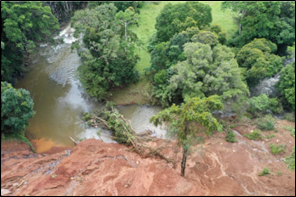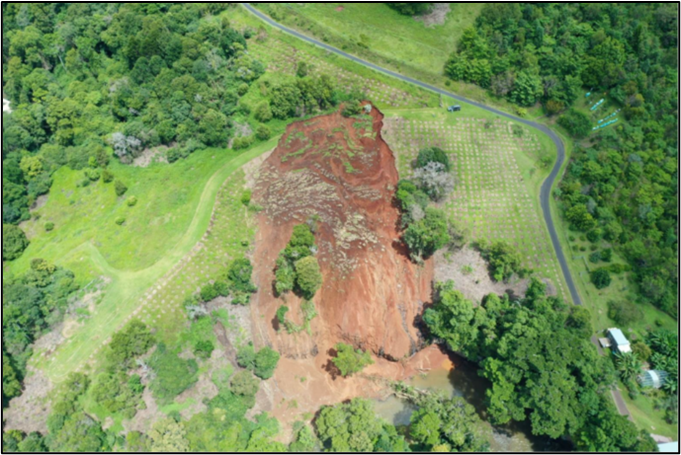Collaborative landslip rehabilitation case study
Disaster Recovery Funding Arrangements Environmental Recovery Program – Riverine Recovery Sub-program, 2021–22 severe events program
This project is an excellent demonstration of the benefits of collaboration in delivering locally-led projects with ongoing regional benefits. Groups that ensured this project was a success included Seqwater, Sunshine Coast Regional Council, the landholder and Lake Baroon Catchment Care Group.

The project site is located in North Maleny in the upper Obi Obi Creek sub catchment, around 8km upstream of Baroon Pocket Dam, within the Sunshine Coast Regional Council area. The project site comprises two properties, one in private landholdings and the other a bushland reserve managed by Council.
In late February 2022, the area experienced rainfall totals of approximately 900mm over a few days, resulting in a large landslip with approximately 6,000 cubic metres of sediment displaced and 1,000 cubic metres of sediment entering Obi Obi Creek (see Figure 1). Revegetation works undertaken in 2021 (approximately 600 plants) were lost and an access road destroyed.

The project to rehabilitate the landslip was supported by the jointly funded Commonwealth-State Disaster Recovery Funding Arrangements (DRFA) – Environmental Recovery Program (ERP) (administered by Department of the Environment, Tourism, Science and Innovation). Seqwater were awarded a $93,860 grant under the Riverine Recovery sub-program, which was complemented by a collaboration between Sunshine Coast Regional Council, Seqwater, the landholder and Lake Baroon Catchment Care Group. The project aimed to repair the landslip footprint by draining the subsurface water, re-profiling the slopes, installing diversion drains and revegetating the affected and surrounding areas to increase longer-term stability and resilience.
Contributions from the landowner (in-kind) and primary producer grant funding supported the installation of diversion drains immediately above and around the landslip to minimise overland flow, installation of sub-surface drains to relieve the build-up of shallow groundwater, construction of a new access road, grass seeding and planting of 1,000 plants upslope.

Seqwater’s DRFA ERP grant funding was used to contract Lake Baroon Catchment Care Group to undertake landslip remediation at the project site and surrounding areas, including planting regional ecosystem specific native tube stock and site maintenance for the first six months post-planting completion. Sunshine Coast Regional Council also contributed $4,100 to purchase more tubestock. A total of 7,780 tubestock plants were successfully installed on the project site.
Seqwater have funded Lake Baroon Catchment Care Group to support ongoing maintenance of the site beyond the first six months and up to five years, to ensure vegetation establishment success. The landowner has also committed to provide in-kind labour to assist with ongoing maintenance.
The project will increase soil stability, reducing the risk of future movement. The plantings will provide a dense network of root systems to bind the soil profile and minimise weed growth. It is estimated that the works will prevent approximately 5,000 cubic metres of sediment movement from the project site into the waterway. Subsurface drains have an estimated effective life of 10 to 20 years, by which time the vegetation should provide adequate stability and transpiration. Establishing vegetation on the banks of Obi Obi Creek will also improve the riparian corridor and provide co-benefits of biodiversity corridors and habitat in the longer term.
This collaboration has delivered much more than any one stand-alone project and includes longer term sustainable outcomes for the site and the region.





